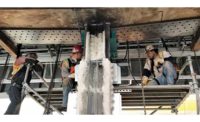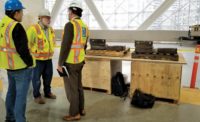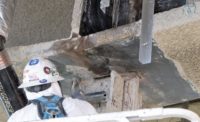The fix is under way of the fractured twin plate girders that span 80 ft across Fremont Street in the 4.5-block-long Salesforce Transit Center in San Francisco, but a reopening date is not yet set, according to the Transbay Joint Powers Authority. TJPA closed the center on Sept. 25, less than two months after it had opened, after a ceiling installer discovered a major crack in the bottom flange of one of the tapered steel-plate girders.
Remedial work begins this weekend on a similar bridge-like system spanning First Street, though inspectors did not discover cracks there. Early on Feb. 2, crews will replace the hydraulic jacks on First Street with a shoring system to allow the reinforcement of the twin parallel girders on the bus deck above First Street, the Transbay Joint Powers Authority announced today, Feb. 1. First Street will be closed during the operation on Feb. 2 and Feb. 3.
If all goes as scheduled, steel plates, under fabrication, would arrive next month for installation. Repairs on Fremont and First Street girders are scheduled to be completed by the first week of June. Shoring will then be removed.
The independent peer review panel of the region’s Metropolitan Transportation Commission (MTA) continues to oversee the TJPA's review of thousands of shop drawings, inspection reports and design documents to determine whether there are any other areas of the building that require inspection before the TJPA reopens the hub.
“While we are eager to welcome the Bay Area back to the transit center, we are balancing this with our responsibility to undertake an appropriate review of the facility,” said Mark Zabaneh, TJPA’s executive director, in a Feb. 1 statement.
Meanwhile, transit operators continue to provide bus service out of the temporary Transbay terminal.
TJPA had announced Jan. 10 that procurement had begun for the repairs, after the MTC panel approved the repair scheme late last year. The fix is designed by the project’s engineer of record, Thornton Tomasetti,
Tapered Plate Girders
Before the problems surfaced, the 1.2-million-sq-ft transit center was functioning as a bus depot, with three levels above grade and a 5.4-acre rooftop park. The third-floor Fremont Street tapered plate girders. 8-ft-deep at their midspan, help support the park directly above and the second-floor bus level—via a hanger at the midspan that thickens the web to 4 in. and slots through the bottom flange—directly below the girder level.
The hub, designed by Pelli Clarke Pelli Architects, was built by the Webcor/Obayashi Joint Venture. Skanska USA Civil West holds the $189.1-million subcontract to furnish the building’s 23,000 tons of structural steel and erect the entire system, including the building’s exotic exoskeleton. Herrick Corp. is the steel fabricator for the girders.
At the TJPA’s January board meeting, Dennis Turchon, TJPA's senior construction manager, announced that the MTC peer review panel had engaged an engineer, Ruby & Associates, to establish the criteria to determine which members of the transit hub may be vulnerable to brittle fracture and to review some 15,000 documents related to design and construction. The criteria will be based on thickness of the steel plate, certain weld types and other elements, he said.
Double Splint
As described by Bruce Gibbons, the TT managing principal in charge of the transit hub, the bolted fix would only repair the compromised region, at the 8-ft-deep midspan of each 80-ft-long girder, by bypassing the fractured area. The double splint consists of a sandwich of two Grade 70 steel plates, 2 in. thick, and a total of 20 in. wide, on both sides of the web. The bent plates will be a total of 14 ft long, centered at the girder's midspan. There will be 224 bolts, said Turchon. In addition, 8-in.-tall plates will be bolted to each girder’s vertical stiffener.
The TJPA has not provided any details about the cause of the fractures.






Post a comment to this article
Report Abusive Comment